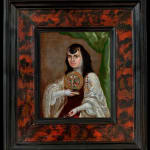A FIRST PORTRAIT OF SOR JUANA INÉS DE LA CRUZ
Unidentified artist, New Spain (Mexico), 1673
Oil on copper.
11..5 x 9 cm.
Provenance
Private collection, Spain.
Inscription 'AEtatis sua 25' This previously unpublished portrait of Sor Juana Inés de la Cruz undoubtedly stands as the only known preserved work painted of the poet during her lifetime,...
Inscription "AEtatis sua 25"
This previously unpublished portrait of Sor Juana Inés de la Cruz undoubtedly stands as the only known preserved work painted of the poet during her lifetime, and in all likelihood the one to which so much research, and so many theories about Sor Juana, have alluded, in the search for the real face of the most celebrated representative of New Spanish literature.
The Latin inscription "Atatis sua 25".' which we can read in the upper left-hand corner of the copper, confirms that this work was painted during the early adulthood of the "Tenth Muse" and allows us, taking her birth as occurring on 12 November 1648,'° to date the execution of this extraordinary historical/artistic narrative to 1673, a seminal year in the life of the poet.
Juana de Asbaje, as she was known before he gave herself up to a religious life, was as misunderstood as she was admired. Feared even, by some, as one fears a fearless woman. Talented, sensitive and extraordinarily intelligent, she did what she could to overcome the obstacles that class and gender put in the way of her intellectual vocation. She learnt to read at the age of three, and dreamt of cutting her hair and donning a moustache so she could enter university, at that time the sole province of men from the wealthy classes. The same men she surprised with her erudition when she became a lady-in-waiting at the viceregal court. Her learning refused to be trampled by the demands of marriage, so she turned her back on worldly life and entered (first as a Carmelite, a few months later as a Hieronymite) an enclosed convent, to which she offered up her entire life. A strategically-chosen scenario in which to give free rein to a life of study that she would dress up in the vestiges of faith.
This portrait of Sor Juana Inés de la Cruz, very much in line with the female and Criollo aesthetic of the day, presents a simple composition: the poet depicted half-length, standing up and almost in profile, an arrangement that differs slightly from the compositional model for portraits of nuns to which we are accustomed. I' and which gives the feeling of presenting us with a celebrated figure from Mexican viceregal society rather than a woman living a cloistered religious existence.



